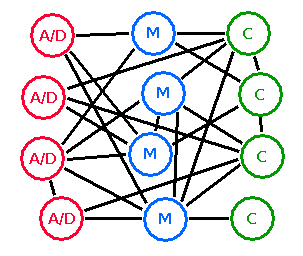|
Earl has a posting about the music business that confuses me. It's not the article that confuses. It's the whole discussion of digital economics versus material economics.
Music today can be obtained two ways, either on a CD or as a download. These are two different economic models, one material and the other digital. The fascinating aspect is that the two so readily overlap. CDs get ripped into digital artifacts, and downloads get compiled onto CDs. Where I get confused is that many discussions blur the distinction between the material and the digital, treating the problem as one unified model. I think that it important to make the distinction so that a clear solution can be devised.
I used to ignore the music problem, thinking that it was an isolated delusion. I've come to understand that the solution to this economic gordian knot will have great impact on many other economic areas in the future. As the development of 3D printers matures, whereby consumers can "print" physical goods (a la The Diamond Age), these same economic issues will become more generalized and more important.
One distinction between the material model and the digital model is the role of pricing as the carrier of information. In a purely material model where only things are traded, price denotes other information like quality, distinctiveness, reputation and demand levels. A Chevy is priced less because it is of lower quality, less distinctiveness and lower reputation and has a widespread but low demand factor compared to a Rolls, which is of high quality, distinctiveness and reputation and has a narrow but high demand factor. I don't know what a pure digital model would look like, because these days we are in the midst of a mixed model where price is used more and more as just a transactional token to induce movement of goods (Wal-Mart is a good example). If this trend continues, then pricing will become less reliable as a carrier of information other than the signification that it is time to buy.
An aspect of the digital model, that is only implied by the music problem but that will become more distinct with 3D printing, is the capabilities of the equipment the user has to transform the digital stream. We are aware of this to a certain extent today, where the same software performs differently depending on the components in our computer -- CPU speed, amount of RAM, etc. In the future, the instructions for the widget we buy will perform differently and therefore output a materially different artifact on the Chevy printer compared to the Rolls printer.
Another issue that gets sidestepped to a certain degree in the music discussion is the interrelation of the artist/designer, the marketer, and the consumer. Earl has a link to an article by Umair Hague which discusses the implied agency role of record labels with respect to consumers. The article is well worth a read, but I'm not sure I agree with the framework of Umair's argument. It seems to me that in the digital model, the three levels will remain but because of the reduced cost of production, marketing and delivery, there will spring up a multitude of one-to-many relationships interconnecting all parties where intangibles such as reputation and quality will delink from price.

If you think about it, this is similar to the model of the fine art markets today to a certain degree.
| 
